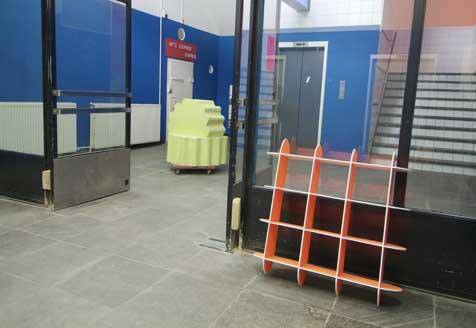Kristof van Gestel
04 Feb - 05 Mar 2006
KRISTOF VAN GASTEL
"What is/What could be"
4- febr- 5 maart 2006
Opening 3 februari 2006 21.00 uur
Participating artists:
Pieter Dobbelsteen, Martijn Olie, Falke Pisano, Armando AndradeTudela, Frank Koolen, Marien Schouten, Reinaard Vanhoe, Marjolijn Dijkman, Dirk Zoete, Virginie Bailly, Francis Denys, Maud Vandeveire, Emanuel Depoorter, Lars Kwakkenbos, Kristof van Gestel, Boris Rebetez, Asier Mendizabal, Jens Nippert, Joe Scanlan, Koenraad Dedobbeleer
With the show ‘What is/What could be’, W139 connects with an old tradition of artist-initiated projects. Van Gestel has realized a group exhibition that takes his own artistic interests and his affinity with the work of artist colleagues as a starting point. He has invited twenty ‘kindred spirits’ to collaborate, most of them contemporaries from the Low Countries. Agreeing with thinkers like Rorty and John Gray, Van Gestel notes that the linear fixation on progress is an essential element of Western intellectual patrimony, and that we apply this concept of the manipulability of our world at micro level in our daily lives. Our belief in a (better) future – both at global and individual level – keeps us going. However, the stories that we tell ourselves in this context continually conflict with the reality of our situation. There is a gap between ‘what could be’ and ‘what is’, and individuals continually have to learn to deal with this rift – the basis of both desire and frustration. What are the options, what are the limitations, and how do you strike a balance between the two? According to Van Gestel, such considerations also play an important role in the professional life of the artist. Which choices - intuitive/spontaneous or well-considered/conceived – does the artist take as the basis of a work, how does he create his own personal vocabulary, how does he use imagery to express an attitude? Van Gestel is interested in artists that approach their environment and their own work with a kind of stubbornness: ‘builders’ who create idiosyncratic systems, which they place opposite complex reality. Artists that admit a form of reasoned intuition in their work and occasionally allow ‘the thing’ to take things over. However, Van Gestel aims to avoid ‘What is/What could be’ becoming an illustration of a statement. First and foremost, he views the exhibition as a (playing) field of ideas, an interaction of twenty different positions and visual languages that are presented opposite and beside one another.
© Kristof van Gestel
A moving Whole of interactive parts (John Dewey)
Image: Henni van Beek
"What is/What could be"
4- febr- 5 maart 2006
Opening 3 februari 2006 21.00 uur
Participating artists:
Pieter Dobbelsteen, Martijn Olie, Falke Pisano, Armando AndradeTudela, Frank Koolen, Marien Schouten, Reinaard Vanhoe, Marjolijn Dijkman, Dirk Zoete, Virginie Bailly, Francis Denys, Maud Vandeveire, Emanuel Depoorter, Lars Kwakkenbos, Kristof van Gestel, Boris Rebetez, Asier Mendizabal, Jens Nippert, Joe Scanlan, Koenraad Dedobbeleer
With the show ‘What is/What could be’, W139 connects with an old tradition of artist-initiated projects. Van Gestel has realized a group exhibition that takes his own artistic interests and his affinity with the work of artist colleagues as a starting point. He has invited twenty ‘kindred spirits’ to collaborate, most of them contemporaries from the Low Countries. Agreeing with thinkers like Rorty and John Gray, Van Gestel notes that the linear fixation on progress is an essential element of Western intellectual patrimony, and that we apply this concept of the manipulability of our world at micro level in our daily lives. Our belief in a (better) future – both at global and individual level – keeps us going. However, the stories that we tell ourselves in this context continually conflict with the reality of our situation. There is a gap between ‘what could be’ and ‘what is’, and individuals continually have to learn to deal with this rift – the basis of both desire and frustration. What are the options, what are the limitations, and how do you strike a balance between the two? According to Van Gestel, such considerations also play an important role in the professional life of the artist. Which choices - intuitive/spontaneous or well-considered/conceived – does the artist take as the basis of a work, how does he create his own personal vocabulary, how does he use imagery to express an attitude? Van Gestel is interested in artists that approach their environment and their own work with a kind of stubbornness: ‘builders’ who create idiosyncratic systems, which they place opposite complex reality. Artists that admit a form of reasoned intuition in their work and occasionally allow ‘the thing’ to take things over. However, Van Gestel aims to avoid ‘What is/What could be’ becoming an illustration of a statement. First and foremost, he views the exhibition as a (playing) field of ideas, an interaction of twenty different positions and visual languages that are presented opposite and beside one another.
© Kristof van Gestel
A moving Whole of interactive parts (John Dewey)
Image: Henni van Beek

